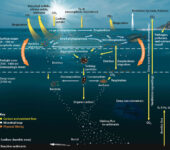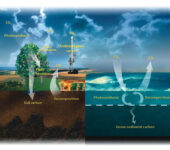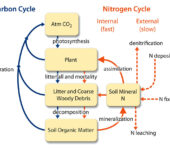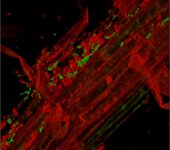Environmental Microbiome
-

Poplar Roots
Confocal microscope images of bacteria on the surface of poplar roots. Viable Pseudomonas sp. GM17 are stained green (with Syto9), and dead cells are stained red (with propidium iodide). The root surface is visualized by autofluorescence.
-

Carbon Transformation
Transformation and Transport in Soil. These processes can result in sequestration of carbon in the soil as organic matter or in groundwater as dissolved carbonates, increased emissions of CO2 to the atmosphere, or export of carbon in various forms into aquatic systems.
-

Oceanic Carbon Capture
In the oceans, the marine biosphere does not take up CO2 directly from the atmosphere. The physical processes controlling the sinking of CO2 into colder, deeper waters (where CO2 is more soluble) and the mixing of ocean water at intermediate depths are known collectively as the “solubility pump.” Phytoplankton photosynthesis converts CO2 into organic carbon that is largely returned to ocean water as CO2 via microbial respiration and decomposition. The “biological pump” refers to the small fraction of organic carbon that forms into degradationresistant clumps and sinks to the ocean floor. Together the solubility and biological pumps control the amount of carbon transported to ocean depths and the exchange of CO2 between ocean and atmosphere.
-

Nitrogen Cycle
Nitrogen biogeochemical cycle in nature.
-

-

-

Rhizosphere Interactions
Confocal microscope images of bacteria on the surface of poplar roots.
-

Rhizosphere Consortia
As the roots of Avena fatua push through soil to acquire nutrients and water, they also provide carbon to a complex microbial community inhabiting the soil environment adjacent to the plant roots.
-

Biodesign Scientists in Laboratory Study Agar Plates
Crosscutting and Multiscale Approach. Biodesign lies at the core of the Genomic Science Program’s three primary research focus areas: Bioenergy, Environmental Microbiome, and Biosystems Design. Here, Nurgul Kaplan (left) and Garima Goyal examine microbial colonies on agar plates in front of an automated microbial transformation-plating and colony-picking robot. The two scientists work in the Robots Room on DNA construction and robotics at the Agile BioFoundry.
-
